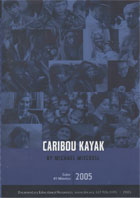
Caribou Kayak 2004
Distributed by Documentary Educational Resources, 101 Morse Street, Watertown, MA 02472; 617-926-0491
Produced by WakeRobin Pictures
Directed by Michael Mitchell
DVD, color, 49 min.
Jr. High - Adult
Canadian Studies, Native American Studies, Anthropology
Date Entered: 03/10/2006
Reviewed by Kristin M. Jacobi, J. Eugene Smith Library, Eastern Connecticut State University, Willimantic, CTThis film opens with some historic footage of an Inuit in a kayak slicing through the water hunting caribou. And with it, the introduction is made that this documentary will be an opportunity for the viewer to see how a skin-on-frame Caribou kayak is made and why it is so special.
In the summer of 2002, Robert Morris, master boat builder and author of “Building Skin-on-Frame Boats,” brings his family and his boat shop partner to the village of Kugaaruk, Nunavut. Morris has arranged for two persons to learn the craft of building this unique boat firsthand from the aging experienced Inuit elders. The premise is to have the elders, Otto Apsaktaun and Gino Akka, and some of their family set up camp on Barrows Lake, 40 kilometers north of Kugaaruk, for two weeks of intense boat building; transferring the knowledge and skills needed to build the sleek Netsilingmeot caribou-hunting kayak to a younger generation. Several other Inuit have signed on to help, including a translator (to translate the elders’ Inuktitut language to English).
A legal services attorney, Jake Herro, and a community health nurse, Shona Lalonde, are the individuals for whom the kayaks will be built. At the end of their weeks together, Jake and Shona will have participated in creating boats built to their exact body length and experienced the ancient craft of shipbuilding directly from those who, in their lifetime, learned these skills from their forefathers and used these boats to hunt for survival. Although the film shows the discussions and explanations of the ancient ways, in this day and age, the boats are constructed using both traditional hand tools and materials, such as antler, and modern power tools and modern materials, including “ballistic nylon” instead of animal skin.
The film follows the group as they arrive at the camp on 4-wheel ATVs, set up the food tent, work laboriously to complete the tasks, and break down camp to return to the village. Toward the end, the weather forces the entire entourage to work indoors at the Kugaaruk Youth and Elder Center. While there, the village youth become more interested in the activity, and the camera crew visits the homes of two elders; a skin-clothing maker, and bone carver.
Every feature of the boat is designed for stability and quickness in the water, and as mentioned before, is individualized which makes for comfortable paddling. On the last day, Jake and Shona paddle their boats in the Arctic waters for the maiden voyages, much to the delight of the participants. The kayaks themselves are “the most perfect little boat.”
Written and directed by Michael Mitchell, a Toronto-based photographer, filmmaker and writer, this film captures just one of the ancient crafts and skill sets that are vanishing in this modern, 21st century world.
Technically, the sights and sounds of the Inuit culture and landscape are well integrated to the storyline. As the footage of the boat building progresses, animated graphics highlighting the construction appear at the bottom of the screen. It is hoped that this intimate view of one aspect of the Inuit culture will, in some small way, preserve it for future generations.
This program would easily fit into a Native American studies program, Canadian studies program or an anthropology class. Also, the avid kayaker, particularly those wanting to build their own, would find this real life boat-building film especially of interest.
Awards
- 2004 WATERWALKER Film Festival, Heritage Category